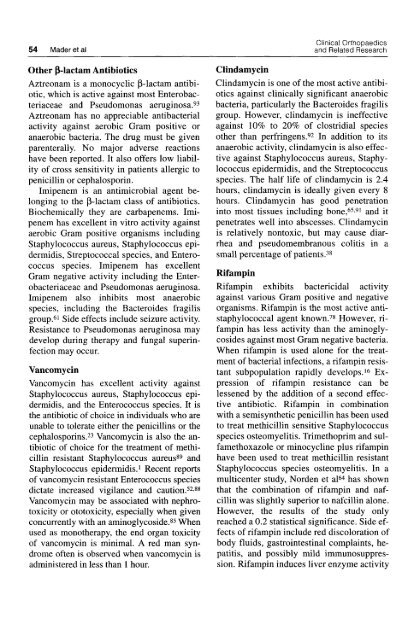Antimicrobial Treatment of Chronic Osteomyelitis - Lippincott ...
Antimicrobial Treatment of Chronic Osteomyelitis - Lippincott ...
Antimicrobial Treatment of Chronic Osteomyelitis - Lippincott ...
You also want an ePaper? Increase the reach of your titles
YUMPU automatically turns print PDFs into web optimized ePapers that Google loves.
54 Maderetal<br />
Other b-lactam Antibiotics<br />
Aztreonam is a monocyclic p-lactam antibiotic,<br />
which is active against most Enterobacteriaceae<br />
and Pseudomonas aeruginosa.93<br />
Aztreonam has no appreciable antibacterial<br />
activity against aerobic Gram positive or<br />
anaerobic bacteria. The drug must be given<br />
parenterally. No major adverse reactions<br />
have been reported. It also <strong>of</strong>fers low liability<br />
<strong>of</strong> cross sensitivity in patients allergic to<br />
penicillin or cephalosporin.<br />
Imipenem is an antimicrobial agent belonging<br />
to the p-lactam class <strong>of</strong> antibiotics.<br />
Biochemically they are carbapenems. Imipenem<br />
has excellent in vitro activity against<br />
aerobic Gram positive organisms including<br />
Staphylococcus aureus, Staphylococcus epidermidis,<br />
Streptococcal species, and Enterococcus<br />
species. Imipenem has excellent<br />
Gram negative activity including the Enterobacteriaceae<br />
and Pseudomonas aeruginosa.<br />
Imipenem also inhibits most anaerobic<br />
species, including the Bacteroides fragilis<br />
group.61 Side effects include seizure activity.<br />
Resistance to Pseudomonas aeruginosa may<br />
develop during therapy and fungal superinfection<br />
may occur.<br />
Vancomy cin<br />
Vancomycin has excellent activity against<br />
Staphylococcus aureus, Staphylococcus epidermidis,<br />
and the Enterococcus species. It is<br />
the antibiotic <strong>of</strong> choice in individuals who are<br />
unable to tolerate either the penicillins or the<br />
cephalosporins.23 Vancomycin is also the antibiotic<br />
<strong>of</strong> choice for the treatment <strong>of</strong> methicillin<br />
resistant Staphylococcus aureus89 and<br />
Staphylococcus epidermidis.' Recent reports<br />
<strong>of</strong> vancomycin resistant Enterococcus species<br />
dictate increased vigilance and caution.52.88<br />
Vancomycin may be associated with nephrotoxicity<br />
or ototoxicity, especially when given<br />
concurrently with an aminoglycoside.85 When<br />
used as monotherapy, the end organ toxicity<br />
<strong>of</strong> vancomycin is minimal. A red man syndrome<br />
<strong>of</strong>ten is observed when vancomycin is<br />
administered in less than 1 hour.<br />
Clinical Orthopaedics<br />
and Related Research<br />
Clindamycin<br />
Clindamycin is one <strong>of</strong> the most active antibiotics<br />
against clinically significant anaerobic<br />
bacteria, particularly the B acteroides fragilis<br />
group. However, clindamycin is ineffective<br />
against 10% to 20% <strong>of</strong> clostridial species<br />
other than perfringens.92 In addition to its<br />
anaerobic activity, clindamycin is also effective<br />
against Staphylococcus aureus, Staphylococcus<br />
epidermidis, and the Streptococcus<br />
species. The half life <strong>of</strong> clindamycin is 2.4<br />
hours, clindamycin is ideally given every 8<br />
hours. Clindamycin has good penetration<br />
into most tissues including bone,65.91 and it<br />
penetrates well into abscesses. Clindamycin<br />
is relatively nontoxic, but may cause diarrhea<br />
and pseudomembranous colitis in a<br />
small percentage <strong>of</strong> patients.38<br />
Rifampin<br />
Rifampin exhibits bactericidal activity<br />
against various Gram positive and negative<br />
organisms. Rifampin is the most active antistaphylococcal<br />
agent known.78 However, rifampin<br />
has less activity than the aminoglycosides<br />
against most Gram negative bacteria.<br />
When rifampin is used alone for the treatment<br />
<strong>of</strong> bacterial infections, a rifampin resistant<br />
subpopulation rapidly develops.16 Expression<br />
<strong>of</strong> rifampin resistance can be<br />
lessened by the addition <strong>of</strong> a second effective<br />
antibiotic. Rifampin in combination<br />
with a semisynthetic penicillin has been used<br />
to treat methicillin sensitive Staphylococcus<br />
species osteomyelitis. Trimethoprim and sulfamethoxazole<br />
or minocycline plus rifampin<br />
have been used to treat methicillin resistant<br />
Staphylococcus species osteomyelitis. In a<br />
multicenter study, Norden et a164 has shown<br />
that the combination <strong>of</strong> rifampin and nafcillin<br />
was slightly superior to nafcillin alone.<br />
However, the results <strong>of</strong> the study only<br />
reached a 0.2 statistical significance. Side effects<br />
<strong>of</strong> rifampin include red discoloration <strong>of</strong><br />
body fluids, gastrointestinal complaints, hepatitis,<br />
and possibly mild immunosuppression.<br />
Rifampin induces liver enzyme activity


